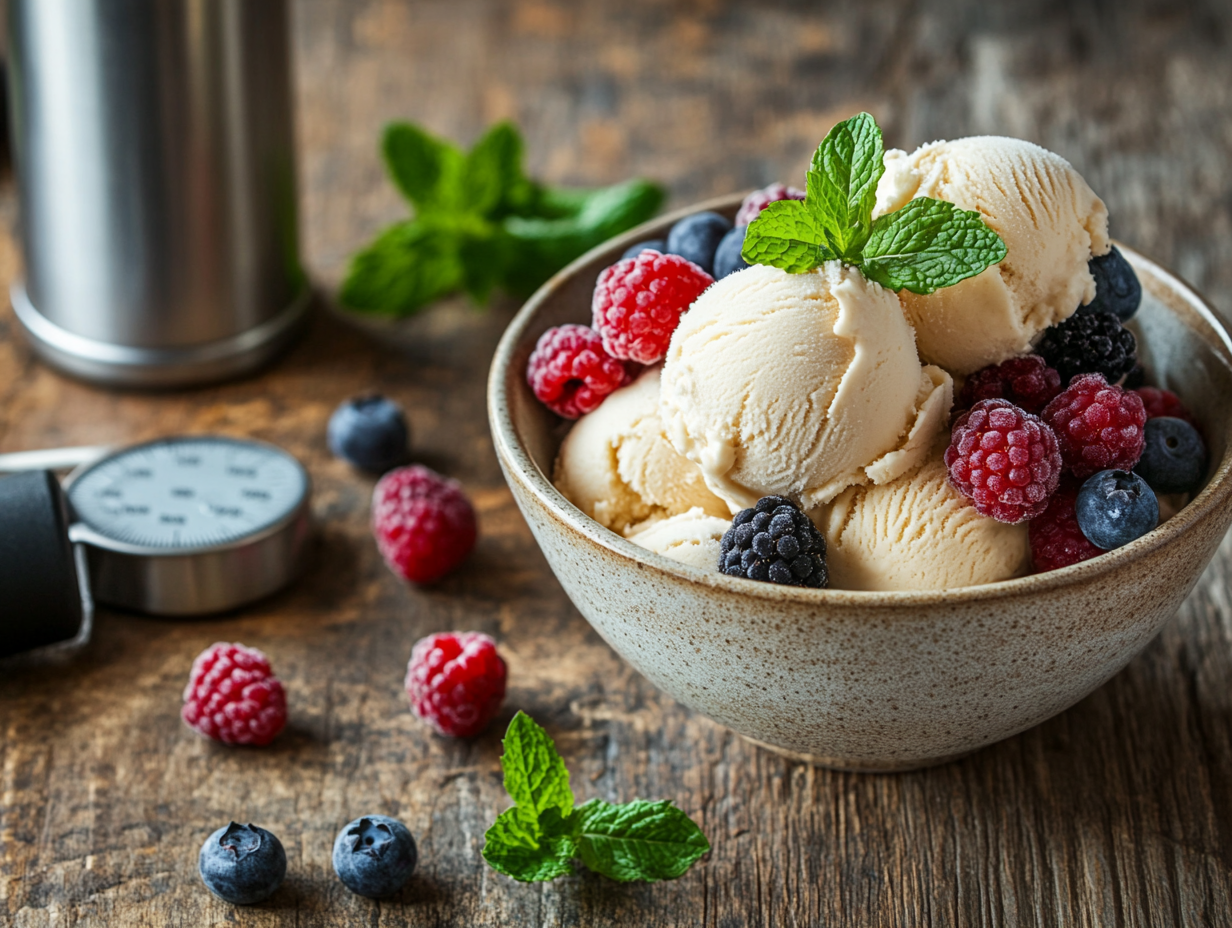Introduction: The Rise of Protein Ice Cream
As fitness and health become more mainstream, people have begun seeking healthier alternatives to their favorite indulgences. One such treat that has gained immense popularity is protein ice cream. With its promises of high protein content, low sugar, and fewer calories, protein ice cream seems like a dream come true for fitness enthusiasts and dessert lovers alike. But the question remains: is protein ice cream healthy, or is it just another marketing ploy? This article takes an in-depth look at the ingredients, nutritional benefits, potential risks, and how to enjoy protein ice cream in a balanced diet.
The Evolution of Protein Ice Cream
Protein ice cream has evolved from niche market products to mainstream availability, largely thanks to the rise of the health-conscious consumer. Traditional ice cream, while delicious, is often packed with added sugars and fats that can derail a healthy lifestyle. Protein ice cream, on the other hand, aims to provide the same indulgent experience with fewer negative health impacts.
But how did we get here? The history of protein-enhanced foods dates back to the fitness boom of the 1970s and 1980s, when athletes began supplementing their diets with protein powders and shakes. Over time, the demand for high-protein products expanded beyond athletes to include anyone looking to maintain a healthy weight, build muscle, or simply live a healthier lifestyle. Enter protein ice cream, the next logical step in making high-protein diets more enjoyable.
Today, brands like Halo Top, Enlightened, and Breyers are household names for their low-calorie, high-protein offerings. However, the question remains: is protein ice cream healthy, or does it come with hidden downsides?
What is Protein Ice Cream?
At its core, protein ice cream is ice cream that has been modified to contain a higher amount of protein, often achieved by adding protein powder or protein-rich ingredients like whey, casein, or even pea protein. Unlike regular ice cream, which is typically made from cream, milk, and sugar, protein ice cream swaps out some of the fat and sugar for protein and sometimes sugar substitutes, like stevia or erythritol.
However, it’s important to note that not all protein ice creams are created equal. Some may be packed with artificial sweeteners and preservatives to maintain texture and flavor, while others take a more natural approach. As a result, the healthiness of protein ice cream can vary widely depending on the brand and the ingredients used.
Breaking Down the Ingredients
Understanding what’s inside your protein ice cream is crucial to determining whether it fits into your diet. Let’s take a closer look at some common ingredients in protein ice cream:
- Protein Sources: The protein in protein ice cream typically comes from whey protein, casein, egg whites, or plant-based proteins like pea protein. Whey and casein are derived from milk and are excellent sources of complete proteins, meaning they contain all nine essential amino acids. Plant-based proteins may lack some amino acids but are ideal for those with dietary restrictions.
- Sugar Substitutes: To keep calories low, protein ice cream often contains sugar substitutes like stevia, monk fruit, or erythritol. These sweeteners provide the same sweetness as sugar without the added calories, but they can sometimes cause digestive issues like bloating or gas.
- Stabilizers and Emulsifiers: To achieve a creamy texture, even without traditional fats, protein ice cream includes stabilizers like guar gum or xanthan gum. These ingredients are generally safe but can contribute to the highly processed nature of some protein ice creams.
- Healthy Fats: Some brands of protein ice cream include small amounts of healthy fats from sources like coconut oil or almond butter. These fats not only improve texture but also contribute to satiety, helping you feel fuller for longer.
Nutritional Benefits of Protein Ice Cream

Protein ice cream offers several key benefits that make it a viable option for those looking to maintain a healthy lifestyle without giving up dessert. Below, we break down the main benefits:
1. High in Protein
One of the main selling points of protein ice cream is, unsurprisingly, its high protein content. A typical serving of protein ice cream contains between 10 to 20 grams of protein, which is significantly more than the 2 to 5 grams found in regular ice cream. Protein is essential for muscle repair, growth, and overall health. Consuming adequate protein helps maintain lean body mass and promotes fat loss, making protein ice cream an attractive option for those on high-protein diets.
For instance, the Protein Ice Cream Recipe on Keller Recipes showcases a delicious way to enjoy a high-protein treat.
2. Low in Calories
Protein ice creams are typically lower in calories than their traditional counterparts. While a serving of regular ice cream may contain anywhere from 250 to 350 calories, a serving of protein ice cream can have as little as 150 calories or even less. This calorie reduction is primarily due to the use of low-calorie sweeteners and the reduced fat content. For those looking to maintain or lose weight, protein ice cream offers a satisfying way to enjoy dessert without significantly increasing daily calorie intake.
3. Low Sugar Content
Sugar content is a major concern when it comes to traditional ice cream. A single serving of regular ice cream can contain upwards of 25 grams of sugar, contributing to weight gain, blood sugar spikes, and a host of other health issues. Protein ice cream, on the other hand, is often sweetened with sugar substitutes, significantly reducing its sugar content. Brands typically use stevia, monk fruit, or sugar alcohols like erythritol, which do not spike blood sugar and contain fewer calories.
For a healthy and low-sugar dessert, try adding protein powder to your homemade ice cream. You can learn more about that in this post.
4. Supports Muscle Growth and Repair
Because of its high protein content, protein ice cream can be a great post-workout snack. After a strenuous workout, your body needs protein to repair damaged muscle tissues and promote growth. Eating protein-rich foods, like protein ice cream, helps kickstart the recovery process. Pair it with other high-protein meals, like the Shrimp and Crab Salad featured on Keller Recipes, for a well-rounded recovery meal.
5. Keeps You Fuller for Longer
Protein has been shown to increase satiety, meaning it helps you feel full for longer periods. This can be especially beneficial for those trying to reduce overall calorie intake or manage cravings. By choosing protein ice cream over regular ice cream, you’re more likely to feel satisfied with a smaller portion, which can help prevent overeating.
Potential Drawbacks of Protein Ice Cream

As with any food, protein ice cream isn’t without its potential downsides. While it offers many benefits, it’s important to be aware of the potential risks and drawbacks before making it a regular part of your diet.
1. Artificial Ingredients
Many protein ice creams rely heavily on artificial sweeteners and stabilizers to mimic the creamy texture and sweet taste of regular ice cream. While these ingredients help keep calories and sugar content low, they may not be the healthiest option. Some people may experience digestive issues, such as bloating, gas, or diarrhea, after consuming sugar alcohols like erythritol or xylitol. Additionally, long-term consumption of artificial sweeteners is still being studied, and there are concerns that they may negatively affect gut health.
To avoid these issues, consider homemade versions or choose brands that prioritize natural ingredients. You can experiment with your own versions by learning how to add protein powder to ice cream.
2. Lack of Healthy Fats
While protein ice cream is lower in fat than traditional ice cream, it’s important to remember that not all fats are bad. Healthy fats, like those found in full-fat dairy products, avocado, and nuts, play a critical role in maintaining brain function, regulating hormones, and promoting heart health. Many protein ice creams are low in fat, but this can also mean they’re missing out on these important nutrients. Additionally, fat helps provide creaminess in ice cream, so low-fat versions may have a different texture or flavor.
If you’re concerned about missing out on healthy fats, consider pairing your protein ice cream with other healthy fat sources, like a small serving of almond butter or a sprinkle of chia seeds.
3. Not Always Low in Calories
While many protein ice creams are marketed as low-calorie, it’s important to check the serving sizes and read nutrition labels carefully. Some brands may offer smaller serving sizes than traditional ice cream, making their calorie counts seem lower. If you eat a larger portion, you could easily consume just as many, if not more, calories than you would with regular ice cream. Be mindful of serving sizes and compare the calorie count to other treats to ensure it fits within your daily goals.
4. Cost and Accessibility
Protein ice creams tend to be more expensive than traditional ice cream. The inclusion of high-quality protein sources and low-calorie sweeteners often drives up the cost. This can make protein ice cream less accessible for individuals on a budget, especially if it becomes a regular indulgence. Furthermore, depending on your location, not all brands may be readily available, making it difficult to find the right product for your needs.
Protein Ice Cream and Weight Loss: Is It Effective?
If you’re following a weight loss plan, protein ice cream can be an effective tool when used correctly. As mentioned earlier, the high protein content helps keep you full, reducing the temptation to snack on other high-calorie, low-nutrient foods. Additionally, the lower calorie count of protein ice cream compared to traditional ice cream means you can enjoy a sweet treat without sabotaging your diet.
However, it’s important to remember that protein ice cream should not be viewed as a magic bullet for weight loss. It’s still possible to overconsume, especially if you eat it in place of more nutrient-dense meals. Instead, aim to incorporate protein ice cream into a well-rounded, calorie-controlled diet that includes plenty of vegetables, lean proteins, and whole grains.
For more low-calorie, high-protein meal ideas, check out the Company Shrimp Pasta Salad, a delicious and filling option.
How to Choose the Healthiest Protein Ice Cream

With so many options on the market, choosing the right protein ice cream can be overwhelming. Here are a few tips to help you make the best choice:
1. Check the Protein Content
Look for a brand that offers at least 10–20 grams of protein per serving. This ensures that you’re getting a decent amount of protein to support muscle growth and recovery.
2. Examine the Sugar Content
Opt for protein ice creams that use natural sweeteners like stevia or monk fruit rather than artificial sweeteners like aspartame. Pay attention to the sugar alcohol content, as some people may experience digestive issues from consuming too much.
3. Read the Ingredient List
The fewer artificial ingredients, the better. Look for brands that use whole, recognizable ingredients and avoid those with long lists of unpronounceable additives.
4. Watch the Calories
Be mindful of the calorie content per serving. While many protein ice creams are lower in calories, some brands offer smaller serving sizes to make the numbers seem more appealing. Compare calories per ounce to get an accurate picture of how a product stacks up against traditional ice cream.
Incorporating Protein Ice Cream Into Your Diet
While protein ice cream can be a healthy option, it’s essential to consume it as part of a balanced diet. Here are a few tips on how to enjoy protein ice cream without overindulging:
- Pair It with Fruit: Add a serving of fresh fruit, such as berries or sliced bananas, to your protein ice cream. This not only boosts the fiber and vitamin content but also adds natural sweetness.
- Make It a Post-Workout Treat: Enjoy protein ice cream after a workout when your body needs protein for muscle repair and recovery. This can help you make the most of your exercise efforts.
- Use It as a Snack, Not a Meal: While protein ice cream can be filling, it shouldn’t replace a balanced meal. Combine it with other healthy snacks, like nuts or a protein shake, to ensure you’re meeting your nutritional needs.
For more ideas on high-protein snacks, visit this guide for a nutrient-dense recipe that’s both satisfying and delicious.
Conclusion: Is Protein Ice Cream Truly Healthy?
So, is protein ice cream healthy? The answer is yes—but with some caveats. Protein ice cream can be a healthier alternative to traditional ice cream, especially for those looking to increase their protein intake and reduce sugar and calorie consumption. However, it’s essential to choose brands that prioritize quality ingredients and avoid overindulging.
Protein ice cream fits best into a well-balanced diet that includes a variety of whole foods. It can be an excellent snack, post-workout treat, or occasional dessert when consumed in moderation.
Ultimately, like any food, protein ice cream is only as healthy as the rest of your diet. Balance is key, and by making mindful choices, you can enjoy this guilt-free treat without compromising your health goals.

